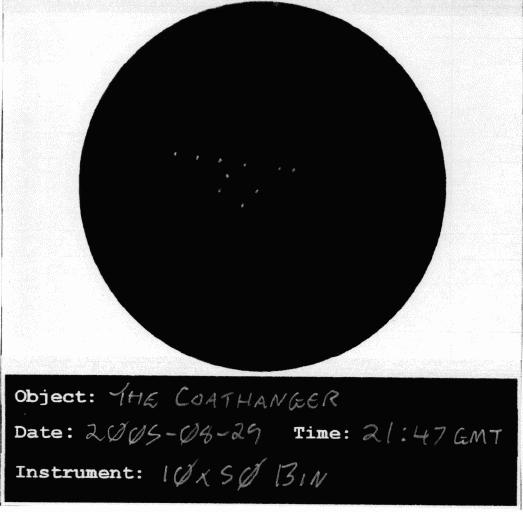|
Saw a satellite in Cygnus. Moved roughly South to
North along and more or less parallel with the "body stars" of the
Swan. First saw it in binocular while doing a general sweep of the
Milky Way and then followed it with naked eye. Was easy to see and
reasonably bright. I wouldn't have put it any brighter than any of
the "body stars" but I wouldn't have put it much fainter than the
faintest of them.
|
|
Tried to see M71 in Sagitta with
binocular. I think I could see it. In the correct location I got
the vague impression of a faint misty patch, quite small, and only
noticeable with averted vision. Seems like a good candidate to
hunt down with the telescope.
|
|
By pure chance, while sweeping the area around Sagitta
and Vulpecula, I stumbled upon The
Coathanger. I was aware of this asterism from books but
hadn't recently taken note of its location was it was a delightful
surprise to stumble on it by accident. While it does sound
terribly obvious it really does look like a
Coathanger.
Having located it once I was very easy to locate it again in the
binocular. It really is a nice sight in the binocular.
At 21:45 UT, while looking at it in the
binocular, a meteor went right through the middle of the field of
view.
Finished off by making a rough sketch. Note that all I did was try
and draw the stars of the Coathanger itself, I didn't bother to
try and draw any of the other stars in the field.

|
|
Had a quick glance at M13. It appeared to be
stunningly bright tonight. I wanted to make a sketch of it as it
appears in the binocular but, as I was getting the drawing gear
together, some cloud moved into the area making it less obvious.
Decided to leave the sketch for another night.
|
|
Went hunting for and found M39 in
Cygnus. Very obvious grouping of stars. Easy to find
thanks to four stars, more or less in a line, close by. Best
description I can give is that it looks like a loose collection of
stars in a roughly triangular shape.
|
|
First noticed a "fuzzy patch" in the sky between Cassiopeia and
Perseus with the naked eye. Check on charts what's there and
realised that it's the double cluster of NGC 869 and
NGC 884 in Perseus (also known as Caldwell 14).
Had a look with binocular. Excellent sight. The best description I
can think of is that it's two star-rich groups of stars, close
together, and made more spectacular by being in a pretty star-rich
field anyway. Also noticed a really nice arc of stars heading away
(roughly North I think) from the pair.
|
|
By now more cloud was forming and rolling in. Decided to pack up.
Just as I was packing up I noticed that Mars had
risen some way above the houses to the East of me. Very bright and
an obvious red tint to it. Nice to see that it's rising earlier
and earlier. Just a couple of weeks
back I didn't notice it until around
22:55 UT. It's starting to get to the point
where there's no excuse for not getting the 'scope out and
starting to observe it.
|
